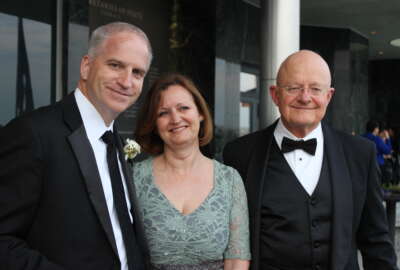For newest class of distinguished executives, focus is on inspiring next generation of leaders
The Presidential Rank Awards Leadership Summit honored more than 70 Distinguished Rank Award winners and more than 215 Meritorious Rank Award winners for both 2016...
Subscribe to Federal Drive’s daily audio interviews on iTunes or PodcastOne.
Even the winners of one of the highest honors in the federal civil service have more to learn.
And while navigating hurricane season, tackling cybercrime or easing veterans homelessness may seem like immense challenges, those projects aren’t nearly as complicated as recruiting, retaining and inspiring the next generation of the Senior Executive Service.
“I encourage you to start … building the next generation of leaders from the very new entrants on up,” Deputy Homeland Security Department Secretary Elaine Duke said Thursday during the Senior Executives Association’s Presidential Rank Awards Leadership Summit in Washington. “That’s when we’ll be seeing the results in the government.”
The summit honored more than 70 Distinguished Rank Award winners and more than 215 Meritorious Rank Award winners for both 2016 and 2017. SEA also coupled this year’s award ceremony with a leadership and learning conference.
The awards go to a small percentage of career SES every year.
But the best leaders, Duke said, are constantly evolving and learning, and they’re passing on those lessons on to the next generation of federal leaders.
But according to an SEA and Deloitte survey of more than 750 members of the Senior Executive Service, the current group of senior career leaders is concerned about the future of the corps.
Only 22 percent of SES respondents said their agencies are well prepared to attract and retain top talent, and 27 percent said their organizations had a plan to recruit new hires from outside of government.
It’s one of the reasons why DHS kicked off a “leadership year” in October and is promoting the phrase, “lead where you are,” to all employees.
“We’re using it to reinforce and build a culture of leadership excellence throughout our department,” Duke said of the program. “[With] ‘leadership year,’ we’re using it to showcase our leaders of today, to help prepare the leaders of tomorrow and to offer opportunities to employees of all levels of DHS to be leaders.”
Duke — who began her professional career as a GS-7 out of college, rose the ranks to become a member of the SES and won her own Presidential Meritorious Rank Award before retiring from the civil service in 2010 — said recent experiences leading the government’s response to three major hurricanes were a recent inspiration.
More than 2,800 non-DHS employees joined the Surge Capacity Force to help with the federal response to Hurricanes Harvey, Irma and Maria, but Duke said she particularly touched when a Coast Guard swimmer handed her the patch from his uniform during one of her visits to Texas.
“It was probably the most humbling experience,” she said. “It’s important for each one [of us] to think about it each day as we’re leaders of an organization. Here’s a guy who just individually rescued over 500 people, left his family, perpetually was being lowered out of airplanes, and here he was giving me [his] patch to thank me. I think that’s our employees. That’s why, I think in coming back especially, leadership is what we need to focus on.”
This year’s hurricane season also prompted Linda McMahon, administrator of the Small Business Administration, to think about her leadership mentality. Before the first hurricane hit, she worked with SBA’s disaster assistance team to complete a practice exercise in the case of a major natural disaster.
After some prompting from McMahon, SBA had developed plans to hire and manage as many as 8,000 employees to help the agency process small business loan applications.
“In the few months since Harvey, we added almost 4,000 employees. We had inter-agency agreements so we were able to utilize people who were already federal employees, who already had background checks and [personal identity verification] cards. … They were immediately available to mobilize.”
McMahon said it was those preparations that helped her agency processed $1 billion in loans in the first 45 days after the first storm this year, compared to the 90 days it took the agency to deal with $1 billion loans during the aftermath of Hurricane Sandy in 2012.
“That would have not have been possible if we had not challenged ourselves to anticipate the need to hire thousands of people so quickly,” she said. “We had a team working to figure out how to be successful.”
For both McMahon and Duke, leadership is continual, ever-evolving process.
“Leadership is not something where you can simply check the box and move on,” McMahon said. “It’s something you must exercise and develop daily. It’s like a muscle. When you do use it, it grows. You feel it, and other people will notice it. You have to exercise it, so it will be stronger to handle the bigger challenges that are likely to follow. You can’t always predict what those challenges will be, but you have to be sure your leadership muscle is really well-conditioned and ready for what’s next.”
For Duke, true senior executive leadership means focusing on the five executive core qualifications — the skills that promising leaders must demonstrate to join the SES.
“The core qualifications aren’t a bingo card,” she said. “You don’t mark them off, join the SES and then bingo, it’s over. We should each be living these core qualifications.”
Agencies and their executives have lost that focus on those core qualities in recent years, Duke said.
“Many of us in the Senior Executive Service are selected based on technical qualifications, again. Or, if you look at those jobs, we have the ECQs, but the technical qualifications are what we’re focusing on, and I really think that’s a mistake. Whether I think of that Coast Guard swimmer or the 250,000 people at DHS who are plugging away day in day out, our job is to be leaders.”
Copyright © 2025 Federal News Network. All rights reserved. This website is not intended for users located within the European Economic Area.
Nicole Ogrysko is a reporter for Federal News Network focusing on the federal workforce and federal pay and benefits.
Follow @nogryskoWFED






